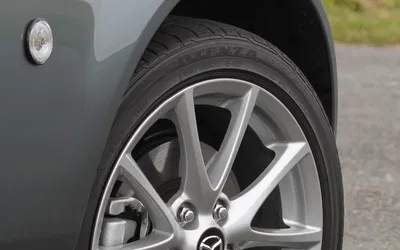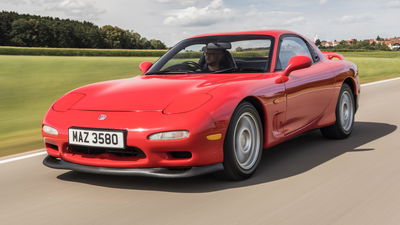NC Mazda MX-5 Buyer's Guide: 10 Things You Need To Know

The Mazda MX-5 marketplace is in a dramatically different place to where it was a few years ago. Decent original NA models are now pretty rare, so unless you want a ratty one, you need to pay a lot of money. The NBs are becoming highly sought after as a result of that, and ND MX-5s haven’t been around long enough to dip below the magic £10,000 mark.
The NC, on the other hand, has never been more tempting. Being a lot younger than NAs and NBs, they’re far less troublesome to own, and can now be bought very cheaply indeed. They’re also a great platform for mods.
To find out what you need to know before taking the plunge, we sat down with Neil McKay of Brackley-based Mazda tuning specialist BBR GTI.
A facelift is desirable, but not essential

In late 2008, the ‘NC1’ became the ‘NC2’ via a facelift that added new front and rear bumpers, fresh light clusters and side skirts. Inside there was more legroom (“knocking knees on door cards” is an issue with earlier cars, Neil says), and under the bonnet, the 2.0-litre engine was given a forged crankshaft. The latter bumps the redline up from 7000 to 7500rpm. There was also a further, less distinctive update in 2013.
Desirable changes, certainly, but the NC2 isn’t enough of a leap forward to make it worth avoiding the NC1 at all costs. If there’s a tidy NC1 in your budget, by all means, go for it - don’t feel it’s necessary to break the bank for an NC2. Just be sure to take heed of our next point…
You need to watch out for rust

“Rust is the enemy of any MX-5, particularly early NCs,” Neil warns. Problem areas to look out for include inside and in front of the rear wheel arches and at the end of the sills. Happily, the tin worm is the only big problem with these cars - otherwise, there isn’t much to expect that’ll give you a headache.
A later NC is arguably better than an early ND

If you’re eying up at the very last examples of the NC, it might be tempting to spend a little more and buy an early ND. Neil’s advice? Don’t. The third-gen car is roomier, he says, as well as being more stable as standard.
The brakes are better too. “The first thing we do to the NDs change callipers, [but] not on NCs,” he explains. On the older cars, beefing up the pads and discs is enough to give good stopping power to match and engine mods. We’ll get to those shortly.
The 1.8's gearbox is a potential deal-breaker

Neil views the entry-level 1.8-litre inline-four as a “sweet engine,” but there’s a problem - they were only ever sold with a five-speed manual gearbox. Paired with a naturally aspirated powertrain, those gears are going to seem awfully long. It'd be best to spend extra and go for the 2.0-litre.
The hardtop is a no-brainer

In 2006 Mazda introduced a folding hardtop version of the NC. The weight penalty was fairly low at 36kg, but in return, buyers got better weather protection, increased security and lower wind noise at speed. The electrically retractable arrangement doesn’t even hamper boot space, as Mazda raised the car’s rear deck slightly to accommodate the stowed roof.
Buyers weren’t put off by the 10 per cent premium, with a 76 per cent take-up rate of the ‘Roadster Coupe’ after it was introduced. With that and how early in the NC’s life the option was launched, there’s a very healthy supply of hardtops on the market.
The engine shouldn't give you any issues

While the bodywork can give you trouble, you won’t need to worry about what’s under the bonnet. “Mechanically they’re bulletproof,” Neil reassures, but with one caveat - the Mazda L engine, mechanically identical to Ford’s Duratec unit of the era, has quite the appetite for oil. Be sure to keep on top of the level, and ideally buy from someone who’s mechanically adept enough to have kept the car topped up as necessary.
Suspension should be at the top of your mods shopping list

If you’re going to change anything, make sure it’s suspension-related. “Standard vehicles roll and pitch around all over the place,” Neil says, but thankfully, this isn’t a hugely expensive thing to sort. A set of decent coilovers will set you back around £800 and transform the handling.
Neil considers 25mm to be the optimum ride height drop, and 30mm to be the limit. Go beyond that and you’ll be left with very little suspension travel and compromised geometry.
N/A tuning is possible up to 225bhp, turbochargers take you beyond 250

Big and easy power gains are usually hard to come by with naturally aspirated engines, but there is still a fair bit of potential to unlock from the 2.0-litre engine. For instance, swapping out the stock manifold and fiddling with the ECU can bump the power up from 158bhp to 180 (or 185 for a post-facelift) at a cost of about £1250 using BBR’s ‘Super 180’ pack.
If you’re happy to part with more like £2150, that can be bundled with a freer-flowing panel air filter and new camshafts in the ‘Super 200’ pack, yielding - as the name suggests - 200bhp, plus 167lb ft of torque (an increase of 26lb ft) and a redline of 7800rpm. The holy grail of N/A options is Super 225, which brings individual throttle bodies into the mix for 225bhp, 174lb ft and a Mk2 Ford Escort rally car-style induction bark. It’s not cheap, mind, at a cost of around £4500.
Beyond that, you need to think about forced induction. BBR and others offer turbo kits for the NC that’ll take you above 250bhp and over 200lb ft of torque at a relatively low boost pressure. The stock internals will cope with that just fine, but if you want to go above 300bhp, it’s time to think about forged pistons and connecting rods (and the crank too, if you have a pre-facelift car). Do so, and the turbo conversion costs will go from £5000 to £7000, not including fitting.
Prefer to go supercharged? BBR's 'Stage One' kit will 248bhp to 213lb ft of torque, costing around £5,750. Going for 'Stage Two' costs about £6700 but returns 302bhp and 227lb ft.
Tyres cost more than you may expect

Although some NCs were fitted with optional 18-inch wheels from the factory, they’re rare. You’re much more likely to end up with a car on 16s or 17s, with recommended tyre sizes of 205/50/16 and 205/45/17. These are reasonably obscure measurements, and that means replacements cost more than you might think.
We’d always recommend pushing the boat out when it comes to new rubber, particularly if you’ve bought an NC on budget boots - upgrading to premium rubber will make a huge difference to the way the car drives. On that front, the Continental Premium Contact 6 looks to be the best bet for the 16s, weighing in about £90 a corner depending on where you buy and any offers kicking around.
Oddly, you’ll pay roughly the same amount for the same tyre in the 17-inch size. There are more ultra-high performance (UHP) options for the bigger wheels, including the Goodyear Eagle F1 Asymmetric 5 and the Michelin Pilot Sport 4. All three are great tyres, but of those we’d be tempted by the Goodyear - you’ll generally pay a lot more for the Michelin, but again, that’ll depend on available offers when you buy.
Budget upwards of £4000

NCs start as low as £2000 these days, but £5000 is a good starting point if you want a really tidy one. Later, lower-mileage cars, especially specials like the 25th Anniversary, still command well over £15,000. A 2.0-litre ‘Sport’ would be our pick since it has a factory-fitted limited-slip differential.















Comments
the Mazda L engine, mechanically identical to Ford’s Duratec unit of the era, has quite the appetite for oil.
If there’s one thing I can attest, it’s how much it drinks oil. I owned a pre-facelift BK (model code for the 1st gen) 3 Sport, and in Canada they all came with the 2.3L engine, so that’s the one I had.
Let’s just say it took so much oil it would have been more economical to switch to an RX-8. The gaskets were probably shot now that I think about it. I was using about a pint of oil per week, or about a pint and a half every 1,000 kms.
Coming back to the NC, I’d say that they’re still rather highly priced compared to NBs. NA pricing is all over the place, with some examples going for 4k-5k CAD and others being twice or even thrice as expensive for similar cars, but NB pricing is usually consistent, with variation between 4k-5k, maybe 6k CAD for the cheaper ones and 10k-12k CAD for the low mileage, later models. However, I rarely see any NC listed for less than 10k CAD, most of which are usually high mileage automatic cars with maintenance to do. I just checked, in fact, and out of over 60 cars, only two were below 10k CAD, and both were barely under that mark.
Also check the coolant reservoir and add that to your replacement list. They often crack and leak coolant out until your engine overheats. If it overheats once, you’ll need a new engine. Luckily you can replace the reservoir with a new OEM part for around $60USD or you can really go bulletproof and get an aluminum one. I have the aluminum reservoir from Flyin Miata on my NC
No Shud, This is the best Order of MEEEEEEEAATTAAA:
NA
NB
ND